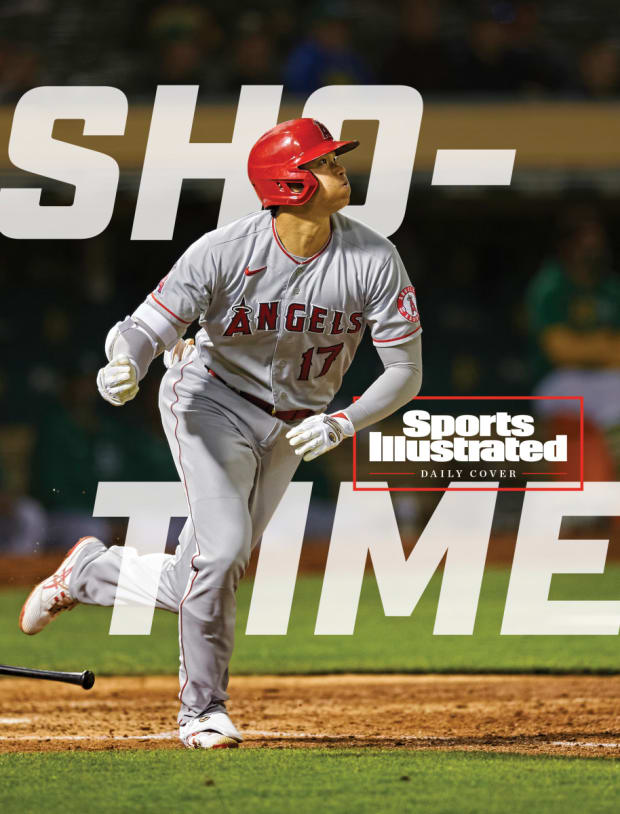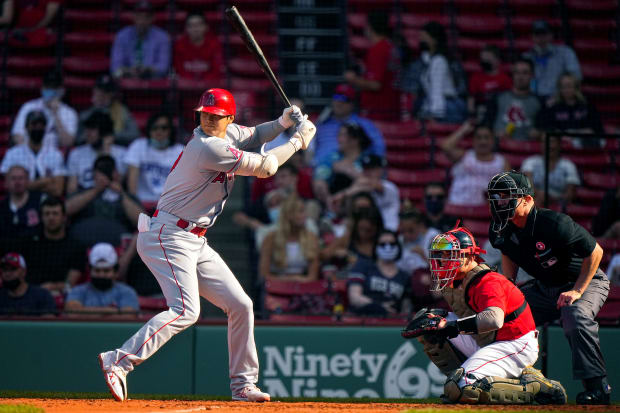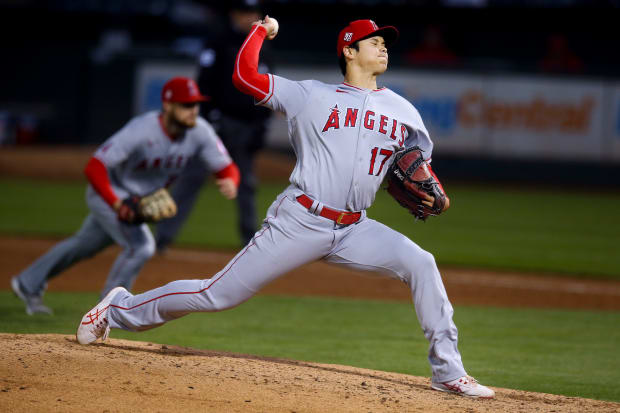Shohei Ohtani inspires double takes, laughter and wonder from baseball fans everywhere, including his fellow All-Stars
Nick Castellanos retired at 12. Nathan Eovaldi retired at 14. Brandon Woodruff retired at 19.
This year’s MLB All-Stars mostly have one thing in common: As children, they were two-way stars. And all but one of them have another thing in common: At some point, they gave it up.
On Tuesday, the other one will become the first player ever to
start the All-Star Game at pitcher and at DH. (MLB had to change the rules to allow the game to proceed normally once he is done.) Shohei Ohtani will do so not quite 22 hours after he became the first pitcher to participate in the Home Run Derby, launching 28 home runs (six went 500 feet or more) and losing the first round in a swing-off to Nationals All-Star right fielder Juan Soto. In games, Ohtani throws 100 mph and drills home runs into the third deck.
“He's must-watch baseball any time he's on the field,” says the opposing starter, Nationals ace Max Scherzer.
This has been the year of Ohtani. He leads the American League in home runs (33), triples (four) and slugging percentage (.698). He ranks fourth among starters with at least 60 innings pitched in strikeouts per nine innings (11.69). He leads the majors in wins above replacement. He inspires double takes, laughter and wonder. (He also inspires the occasional bad take.) Yet he describes himself in a remarkably understated way. Through interpreter Ippei Mizuhara, he says, “Everyone has very high expectations for me, and I just want to match those expectations.”
Indeed. Fans will spend Tuesday gawking at the most complete baseball player in the history of the game. His fellow All-Stars might be even more astounded.
“I’m amazed by it,” says Red Sox ace Eovaldi, who realized after his freshman year of high school that he would never be a good hitter. “I wish I could do it. I just know how I feel coming off a start. I can’t imagine how he’s able to go out there and DH the next day. And the whole routine of things: I feel like I have to practice so much, the bullpens and the side work, and you see the hitters in the cage. I don’t understand how he has enough time to do both and be so good at it.”
Many players expressed awe at Ohtani’s apparent ability to find 25 hours in a day. He must work out as a pitcher and a hitter, do drills as a pitcher and a hitter, study scouting reports as a pitcher and a hitter. It’s all his peers can do to be good at one job. They do not understand how he can do two.

Blue Jays shortstop Marcus Semien, who retired after high school because he could not throw a breaking ball, marvels at Ohtani’s dedication. “I don’t know when the guy sits down and relaxes,” Semien says.
Time was the limiting factor for Padres second baseman Jake Cronenworth, who pitched seven times for the Rays’ Triple A team in 2019 before a trade to San Diego. He pitched and played the infield in spring training ’20, but after the pandemic paused the season, the team asked him to focus on being a position player. He watches Ohtani and feels awe, not nostalgia.
“I enjoyed doing it,” says Cronenworth. “It was really fun. But it was really hard.”
Angels first baseman Jared Walsh, who also made it to the majors as a two-way player, tells a similar story. He pitched five innings in 2019, but he had to sacrifice his infield work to do it. He was relieved last spring when manager Joe Maddon told him to focus on his bat.
“Pitching’s a little bit painful sometimes,” says Walsh. “I don’t feel like putting my body through it if the team doesn’t necessarily need it.”
For the most part, though, it was talent that ended players’ two-way dreams. “They never even let me touch [a bat]” at Vanderbilt, says Dodgers righty Walker Buehler, who retired at 18. He adds, “I’m very glad I don’t have to try [to be a two-way player in the majors]. I get one hit every once in a while and feel good about that.”
Reds right fielder Castellanos did not even make it to his teens. By seventh grade, he was hitting well enough to join his high school team—which meant a move to 90-foot basepaths and a mound 60 feet, 6 inches from home plate. “It was just too far,” he says. “I shut it down.”
Words fail him when it comes to the man doing what he could not. “I can’t—I don't know—I can’t even describe the work, the mental preparation, everything that he needs to do to keep himself healthy and do it at this level,” Castellanos says. “Nothing but respect for this kid making history.”

Brewers ace Woodruff made it as far as his freshman year at Mississippi State. “I saw 95,” he says. That was the end of that.
So he can appreciate the way Ohtani feasts on velocity. He is slugging .778 on pitches of at least 95 mph, second among regulars only to Dodgers All-Star first baseman Max Muncy, who will bat second against Ohtani on Tuesday. “It’s unbelievable what he's doing, the way the guys are throwing so hard now,” Woodruff says. “Oh my gosh. And he’s hitting breaking pitches. He’s taking it the other way. What he’s doing is not heard of.”
White Sox righty Lance Lynn got through his freshman year, too. He believed he could keep hitting at Ole Miss. His coaches disagreed. “When I got to [my sophomore year of] college, they were like, ‘You’re pitching, and we’ll worry about the other stuff later,’” says Lynn. “Later means maybe if you get to the National League you’ll hit.”
Phillies catcher J.T. Realmuto closed for his high school team, but it never occurred to him that he might be able to pursue a career as a two-way player. If he were a teenager now, he says, he might think differently.
“I think it's inspirational, what he's doing,” says Realmuto. “Now if you have a kid who’s 12 years old and he's really good at both, he can look at Shohei and say, ‘Hey, it’s possible. Maybe I’ll do both. Maybe I’ll be the next one.’”

Lynn hoped so. He was looking forward to the Home Run Derby. He wanted to watch Ohtani hit. He also wanted his nine-year-old daughter, Mia, to watch. He wanted to remind her that kids don’t have to specialize in sports, that they can try to do it all.
“He also pitches just like Dad does,” he planned to tell her.
“She’ll go, ‘Oh man, he’s way better than you,’” Lynn predicted. “And I’ll say, ‘You’re right.’ ”
More MLB Coverage:
• Shohei Ohtani Isn't Babe Ruth—He's Better
• The Last Giant: The Cultural Clout of Willie Mays
• How Should the Braves Move Forward Without Ronald Acuña Jr.?
• The Charmed Season: Revisiting Derek Jeter’s Origin Story
Read more of SI's Daily Cover stories here
Shohei Ohtani inspires double takes, laughter and wonder from baseball fans everywhere, including his fellow All-Stars
Nick Castellanos retired at 12. Nathan Eovaldi retired at 14. Brandon Woodruff retired at 19.
This year’s MLB All-Stars mostly have one thing in common: As children, they were two-way stars. And all but one of them have another thing in common: At some point, they gave it up.
On Tuesday, the other one will become the first player ever to start the All-Star Game at pitcher and at DH. (MLB had to change the rules to allow the game to proceed normally once he is done.) Shohei Ohtani will do so not quite 22 hours after he became the first pitcher to participate in the Home Run Derby, launching 28 home runs (six went 500 feet or more) and losing the first round in a swing-off to Nationals All-Star right fielder Juan Soto. In games, Ohtani throws 100 mph and drills home runs into the third deck.

“He's must-watch baseball any time he's on the field,” says the opposing starter, Nationals ace Max Scherzer.
This has been the year of Ohtani. He leads the American League in home runs (33), triples (four) and slugging percentage (.698). He ranks fourth among starters with at least 60 innings pitched in strikeouts per nine innings (11.69). He leads the majors in wins above replacement. He inspires double takes, laughter and wonder. (He also inspires the occasional bad take.) Yet he describes himself in a remarkably understated way. Through interpreter Ippei Mizuhara, he says, “Everyone has very high expectations for me, and I just want to match those expectations.”
Indeed. Fans will spend Tuesday gawking at the most complete baseball player in the history of the game. His fellow All-Stars might be even more astounded.
“I’m amazed by it,” says Red Sox ace Eovaldi, who realized after his freshman year of high school that he would never be a good hitter. “I wish I could do it. I just know how I feel coming off a start. I can’t imagine how he’s able to go out there and DH the next day. And the whole routine of things: I feel like I have to practice so much, the bullpens and the side work, and you see the hitters in the cage. I don’t understand how he has enough time to do both and be so good at it.”
Many players expressed awe at Ohtani’s apparent ability to find 25 hours in a day. He must work out as a pitcher and a hitter, do drills as a pitcher and a hitter, study scouting reports as a pitcher and a hitter. It’s all his peers can do to be good at one job. They do not understand how he can do two.

Blue Jays shortstop Marcus Semien, who retired after high school because he could not throw a breaking ball, marvels at Ohtani’s dedication. “I don’t know when the guy sits down and relaxes,” Semien says.
Time was the limiting factor for Padres second baseman Jake Cronenworth, who pitched seven times for the Rays’ Triple A team in 2019 before a trade to San Diego. He pitched and played the infield in spring training ’20, but after the pandemic paused the season, the team asked him to focus on being a position player. He watches Ohtani and feels awe, not nostalgia.
“I enjoyed doing it,” says Cronenworth. “It was really fun. But it was really hard.”
Angels first baseman Jared Walsh, who also made it to the majors as a two-way player, tells a similar story. He pitched five innings in 2019, but he had to sacrifice his infield work to do it. He was relieved last spring when manager Joe Maddon told him to focus on his bat.
“Pitching’s a little bit painful sometimes,” says Walsh. “I don’t feel like putting my body through it if the team doesn’t necessarily need it.”
For the most part, though, it was talent that ended players’ two-way dreams. “They never even let me touch [a bat]” at Vanderbilt, says Dodgers righty Walker Buehler, who retired at 18. He adds, “I’m very glad I don’t have to try [to be a two-way player in the majors]. I get one hit every once in a while and feel good about that.”
Reds right fielder Castellanos did not even make it to his teens. By seventh grade, he was hitting well enough to join his high school team—which meant a move to 90-foot basepaths and a mound 60 feet, 6 inches from home plate. “It was just too far,” he says. “I shut it down.”
Words fail him when it comes to the man doing what he could not. “I can’t—I don't know—I can’t even describe the work, the mental preparation, everything that he needs to do to keep himself healthy and do it at this level,” Castellanos says. “Nothing but respect for this kid making history.”

Brewers ace Woodruff made it as far as his freshman year at Mississippi State. “I saw 95,” he says. That was the end of that.
So he can appreciate the way Ohtani feasts on velocity. He is slugging .778 on pitches of at least 95 mph, second among regulars only to Dodgers All-Star first baseman Max Muncy, who will bat second against Ohtani on Tuesday. “It’s unbelievable what he's doing, the way the guys are throwing so hard now,” Woodruff says. “Oh my gosh. And he’s hitting breaking pitches. He’s taking it the other way. What he’s doing is not heard of.”
White Sox righty Lance Lynn got through his freshman year, too. He believed he could keep hitting at Ole Miss. His coaches disagreed. “When I got to [my sophomore year of] college, they were like, ‘You’re pitching, and we’ll worry about the other stuff later,’” says Lynn. “Later means maybe if you get to the National League you’ll hit.”
Phillies catcher J.T. Realmuto closed for his high school team, but it never occurred to him that he might be able to pursue a career as a two-way player. If he were a teenager now, he says, he might think differently.
“I think it's inspirational, what he's doing,” says Realmuto. “Now if you have a kid who’s 12 years old and he's really good at both, he can look at Shohei and say, ‘Hey, it’s possible. Maybe I’ll do both. Maybe I’ll be the next one.’”

Lynn hoped so. He was looking forward to the Home Run Derby. He wanted to watch Ohtani hit. He also wanted his nine-year-old daughter, Mia, to watch. He wanted to remind her that kids don’t have to specialize in sports, that they can try to do it all.
“He also pitches just like Dad does,” he planned to tell her.
“She’ll go, ‘Oh man, he’s way better than you,’” Lynn predicted. “And I’ll say, ‘You’re right.’ ”
More MLB Coverage:
• Shohei Ohtani Isn't Babe Ruth—He's Better
• The Last Giant: The Cultural Clout of Willie Mays
• How Should the Braves Move Forward Without Ronald Acuña Jr.?
• The Charmed Season: Revisiting Derek Jeter’s Origin Story


0 Comments